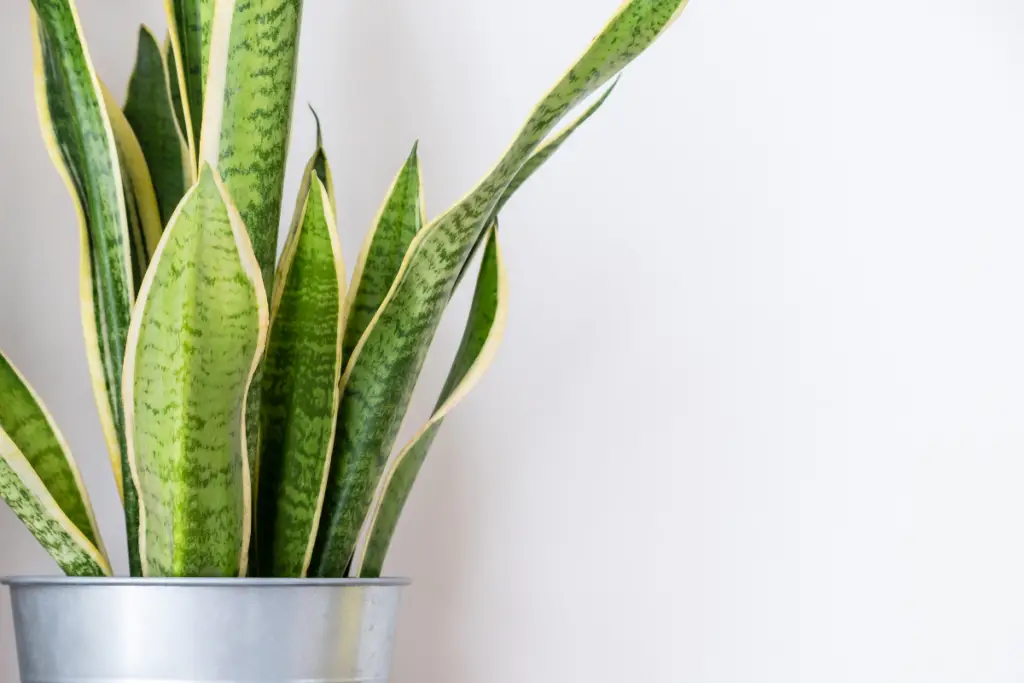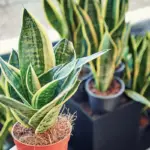Snake plants, also known as Sansevieria, are popular houseplants that are easy to care for and can thrive in various lighting conditions.
They are also known for their air-purifying abilities, making them a great addition to any home. However, to keep your snake plant healthy and thriving, it is essential to provide it with the right nutrients, including fertilizer.
When it comes to choosing the best fertilizer for snake plants, there are a few things to consider.
First, it is important to choose a fertilizer that is balanced and contains equal amounts of nitrogen, phosphorus, and potassium (NPK).
This will ensure that your snake plant receives all the necessary nutrients it needs to grow and thrive.
Additionally, slow-release fertilizers are a great option for snake plants, as they can provide a steady supply of nutrients over an extended period.
Overall, choosing the right fertilizer for your snake plant is essential to ensure its health and vitality.
By selecting a balanced, slow-release fertilizer, you can provide your plant with the nutrients it needs to thrive and grow, making it a beautiful addition to your home.

Table of Contents
Understanding Snake Plants
Snake plants, also known as Sansevieria, are a popular choice for indoor gardening. They are low-maintenance, drought-tolerant, and can thrive in a variety of lighting conditions.
Snake plants are also known for their air-purifying properties, making them a great addition to any home or office.
These plants have long, sword-shaped leaves that can grow up to several feet tall. They are native to West Africa and are part of the Asparagaceae family.
Snake plants are also known for their ability to tolerate neglect and thrive in low-light conditions.
One of the most important factors to consider when caring for a snake plant is fertilization. While snake plants do not require frequent fertilization, providing them with the right nutrients can help promote growth and keep them healthy.
When it comes to choosing a fertilizer for snake plants, it’s important to look for a balanced NPK ratio.
This means that the fertilizer contains equal amounts of nitrogen, phosphorus, and potassium. A balanced fertilizer can help promote healthy foliage growth and improve the plant’s overall health.
It’s also important to consider the plant’s growth stage when fertilizing. During the growing season, which typically occurs from early spring to late summer, snake plants may benefit from more frequent fertilization.
However, during the dormant season, which occurs in the fall and winter, fertilization should be reduced or stopped altogether.
Overall, snake plants are a great choice for indoor gardening, thanks to their low-maintenance and air-purifying properties.
By understanding their fertilization needs, you can help ensure that your snake plant stays healthy and vibrant for years to come.
Why Fertilizer Is Important For Snake Plants
Snake plants are known for their hardiness and ability to thrive in low light conditions, making them a popular choice for indoor plants. However, even the most resilient plants need nutrients to grow and thrive. This is where fertilizers come in.
Fertilizers provide essential nutrients that snake plants need to grow healthy and strong. These nutrients include nitrogen (N), phosphorus (P), and potassium (K), also known as macronutrients.
Snake plants also require micronutrients such as iron, magnesium, and calcium, which are often found in fertilizers.
Without proper fertilization, snake plants can become stunted and may not produce new growth. They may also become more susceptible to pests and diseases.
Therefore, it is important to provide snake plants with the right type of fertilizer at the right time to ensure their optimal growth and health.
It is important to note that over-fertilization can be just as harmful as under-fertilization. Too much fertilizer can cause root burn and damage the plant’s leaves, while also polluting the surrounding environment.
Therefore, it is crucial to follow the manufacturer’s instructions and use fertilizers in moderation.
In the next section, we will discuss the different types of fertilizers that are best for snake plants.
Types Of Fertilizers
There are various types of fertilizers available in the market that can be used to fertilize snake plants.
Each type of fertilizer has its unique features and benefits. Here are some of the most commonly used types of fertilizers for snake plants:
Liquid Fertilizers
Liquid fertilizers are one of the most popular types of fertilizers for snake plants. They are easy to use and can be applied directly to the soil.
Liquid fertilizers are available in both organic and synthetic forms. Organic liquid fertilizers are made from natural sources like fish emulsion, seaweed, and bone meal. Synthetic liquid fertilizers, on the other hand, are made from chemicals.
Prices pulled from the Amazon Product Advertising API on:
Product prices and availability are accurate as of the date/time indicated and are subject to change. Any price and availability information displayed on [relevant Amazon Site(s), as applicable] at the time of purchase will apply to the purchase of this product.
Granular Fertilizers
Granular fertilizers are another popular type of fertilizer for snake plants. They are slow-release fertilizers that release nutrients over a period of time.
Granular fertilizers are easy to apply and can be mixed into the soil or sprinkled on top of the soil. They are available in both organic and synthetic forms.
Prices pulled from the Amazon Product Advertising API on:
Product prices and availability are accurate as of the date/time indicated and are subject to change. Any price and availability information displayed on [relevant Amazon Site(s), as applicable] at the time of purchase will apply to the purchase of this product.
Slow-Release Fertilizers
Slow-release fertilizers are designed to release nutrients slowly over a period of time. They are available in both organic and synthetic forms.
Slow-release fertilizers are easy to use and can be mixed into the soil or sprinkled on top of the soil.
They are a good choice for snake plants that require less frequent fertilization.
Prices pulled from the Amazon Product Advertising API on:
Product prices and availability are accurate as of the date/time indicated and are subject to change. Any price and availability information displayed on [relevant Amazon Site(s), as applicable] at the time of purchase will apply to the purchase of this product.
Organic Fertilizers
Organic fertilizers are made from natural sources like animal manure, compost, and bone meal. They are a good choice for snake plants that prefer organic fertilizers.
Organic fertilizers are slow-release fertilizers that release nutrients over a period of time. They are easy to use and can be mixed into the soil or sprinkled on top of the soil.
Synthetic Fertilizers
Synthetic fertilizers are made from chemicals and are a good choice for snake plants that require a quick boost of nutrients.
They are fast-acting fertilizers that release nutrients quickly. Synthetic fertilizers are available in both liquid and granular forms.
They should be used with caution as overuse can lead to soil depletion and environmental pollution.
Overall, the type of fertilizer used for snake plants depends on the specific needs of the plant.
It is important to choose a fertilizer that is appropriate for the plant’s growth stage and environmental conditions.
Organic Fertilizers
Snake plants can also benefit from organic fertilizers, which are derived from natural sources. Unlike chemical fertilizers, organic fertilizers are less likely to harm the plant or the environment.
Organic fertilizers can also improve soil quality by increasing its nutrient content and improving its structure.
Compost
Compost is a popular organic fertilizer that can be made at home. It is made by combining yard waste and kitchen scraps and allowing them to decompose over time.
Compost is rich in nutrients and can improve soil quality. To use compost as a fertilizer, mix it into the soil around the snake plant’s roots.
Worm Castings
Worm castings are another organic fertilizer that can be used for snake plants. They are produced by earthworms and are rich in nutrients such as nitrogen, phosphorus, and potassium.
Worm castings can improve soil structure and water retention. To use worm castings as a fertilizer, mix them into the soil around the snake plant’s roots.
Bone Meal
Bone meal is an organic fertilizer made from ground animal bones. It is rich in phosphorus, which is essential for plant growth and development.
Bone meal can improve root development and flower formation. To use bone meal as a fertilizer, sprinkle it around the base of the snake plant and water it in.
When using organic fertilizers, it is important to follow the instructions on the package and not to over-fertilize the plant.
Over-fertilizing can cause nutrient burn and harm the plant. Organic fertilizers may also take longer to release nutrients into the soil compared to chemical fertilizers. However, they can provide long-term benefits to the plant and the soil.
Chemical Fertilizers
When it comes to fertilizing a snake plant, chemical fertilizers are a popular option as they provide a quick and easy way to deliver essential nutrients to the plant.
These fertilizers come in different formulations, each with a specific balance of nitrogen, phosphorus, and potassium, which are the primary macronutrients that plants need to grow.
Nitrogen-Based
Nitrogen is a crucial nutrient that plays a vital role in the growth and development of plants. It is a component of chlorophyll, which is responsible for photosynthesis, and helps plants produce amino acids, enzymes, and proteins.
Nitrogen-based fertilizers are ideal for snake plants that need a boost in foliage growth. These fertilizers have a higher percentage of nitrogen, which promotes leafy growth.
Prices pulled from the Amazon Product Advertising API on:
Product prices and availability are accurate as of the date/time indicated and are subject to change. Any price and availability information displayed on [relevant Amazon Site(s), as applicable] at the time of purchase will apply to the purchase of this product.
Phosphorus-Based
Phosphorus is another essential nutrient that is necessary for plant growth. It helps plants produce energy, promotes root growth, and aids in the development of flowers and fruits.
Phosphorus-based fertilizers are ideal for snake plants that need help with root development and flowering.
These fertilizers have a higher percentage of phosphorus, which promotes root growth and flower development.
Prices pulled from the Amazon Product Advertising API on:
Product prices and availability are accurate as of the date/time indicated and are subject to change. Any price and availability information displayed on [relevant Amazon Site(s), as applicable] at the time of purchase will apply to the purchase of this product.
Potassium-Based
Potassium is a macronutrient that helps plants regulate water balance, promotes disease resistance, and aids in the development of fruits and flowers.
Potassium-based fertilizers are ideal for snake plants that need help with overall plant health, disease resistance, and fruit and flower development.
These fertilizers have a higher percentage of potassium, which promotes overall plant health and disease resistance.
In conclusion, selecting the right chemical fertilizer for a snake plant will depend on the specific needs of the plant.
Nitrogen-based fertilizers are ideal for promoting foliage growth, phosphorus-based fertilizers are ideal for root development and flowering, and potassium-based fertilizers are ideal for overall plant health and disease resistance.
It is important to follow the manufacturer’s instructions carefully and avoid over-fertilizing the plant, which can lead to root burn and other issues.
Prices pulled from the Amazon Product Advertising API on:
Product prices and availability are accurate as of the date/time indicated and are subject to change. Any price and availability information displayed on [relevant Amazon Site(s), as applicable] at the time of purchase will apply to the purchase of this product.
How To Apply Fertilizer To Snake Plants
When it comes to fertilizing snake plants, it is essential to know how to apply fertilizer correctly. Here are some steps to follow:
- Choose the right fertilizer: Snake plants benefit from applications of a balanced fertilizer with a ratio of NPK 10:10:10 or 20:20:20. It is essential to choose a high-quality fertilizer that contains all the necessary macronutrients and micronutrients to ensure healthy growth.
- Mix the fertilizer: Before applying fertilizer to the snake plant, mix it with water according to the instructions on the package. It is crucial to dilute the fertilizer properly to avoid over-fertilization, which can damage the plant.
- Apply the fertilizer: Once the fertilizer is mixed, pour it onto the soil around the base of the snake plant. Avoid getting the fertilizer on the leaves or stem of the plant, as it can burn them.
- Water the plant: After applying the fertilizer, water the snake plant thoroughly to help the nutrients reach the roots. It is essential to water the plant until the soil is moist but not waterlogged.
- Keep track of fertilization: Snake plants need fertilization every two months during the growing season (spring and summer). Keep track of when you last fertilized the plant to avoid over-fertilization.
By following these steps, you can ensure that your snake plant receives the right amount of nutrients to grow healthy and strong. Remember to choose the right fertilizer, mix it properly, apply it correctly, water the plant, and keep track of fertilization.
When To Fertilize Snake Plants
Snake plants are easy-going and do not require frequent fertilization. In general, they need to be fertilized once or twice a year.
The best time to fertilize snake plants is during the growing season, which is from early spring to late summer. During this time, the plant is actively growing and needs nutrients to support its growth.
When it comes to fertilizing snake plants, it is important to avoid over-fertilization, as this can damage the plant.
Over-fertilization can cause the leaves to turn yellow or brown, and can even kill the plant. It is recommended to use a balanced 10-10-10 or 20-20-20 fertilizer every 4-6 weeks for ideal growth.
Slow-release fertilizers are also a good option for snake plants. These fertilizers only need to be provided once, and they release nutrients slowly over time.
However, depending on the longevity of the fertilizer, a follow-up feed later in the growing season may be required.
It is important to note that the frequency of fertilization may vary depending on the type of soil used, the amount of light the plant receives, and the size of the plant.
In general, snake plants that receive full sun should be fertilized every other month in the spring through early fall.
On the other hand, snake plants that receive low light should only be fertilized once in the late spring or summer.
Overall, snake plants are relatively low-maintenance and do not require frequent fertilization. By following the recommended fertilization schedule and avoiding over-fertilization, snake plants can thrive and grow to their full potential.
Common Mistakes While Fertilizing Snake Plants
When it comes to fertilizing snake plants, there are a few common mistakes that people often make. Here are some of the most common mistakes to avoid:
Over-fertilization
One of the most common mistakes people make when fertilizing snake plants is over-fertilizing.
Snake plants are hardy plants that don’t require a lot of fertilizer, and too much can actually harm the plant.
Signs of over-fertilization include brown tips on the leaves, yellowing leaves, and stunted growth.
Using the Wrong Fertilizer
Another common mistake is using the wrong type of fertilizer. Snake plants benefit from a balanced fertilizer with a ratio of nitrogen, phosphorus, and potassium (NPK) of 10-10-10 or 20-20-20.
Using a fertilizer with a different ratio can lead to nutrient deficiencies or excesses, which can harm the plant.
Fertilizing Water-logged Soil
Fertilizing a snake plant that is growing in water-logged soil can also be a mistake. When the soil is too wet, the roots can’t absorb the nutrients from the fertilizer, and it can lead to root rot.
It’s important to make sure the soil is well-draining and not too wet before fertilizing.
Not Following the Instructions
Finally, not following the instructions on the fertilizer package can also be a mistake. Different fertilizers have different instructions for how much to use and how often to apply it.
It’s important to read the instructions carefully and follow them to avoid over-fertilizing or under-fertilizing the plant.
By avoiding these common mistakes, you can ensure that your snake plant gets the right amount of fertilizer it needs to thrive.
Conclusion
In conclusion, snake plants are relatively low maintenance and require minimal fertilization. However, to ensure the best growth and health of the plant, it is important to fertilize it occasionally.
The best kind of fertilizer for snake plants is one with a balanced NPK ratio. A fertilizer with an NPK ratio of 10-10-10 or 20-20-20 is ideal. Organic fertilizers like fish emulsion or seaweed extract are also good options.
It is important to fertilize snake plants during the growing season, which is typically from early spring to late summer.
Fertilize every other month for plants that receive full sun. Slow-release fertilizers only need to be provided once during the growing season.
When fertilizing snake plants, it is crucial to avoid over-fertilizing as it can cause salt buildup in the soil, which can be toxic to the plant.
Always fertilize when the soil is moist and follow the instructions on the fertilizer package carefully.
Overall, with proper fertilization and care, snake plants can thrive and make a beautiful addition to any home or office.
- How to Dry Basil Leaves: A Professional Guide
- Is an Avocado a Fruit or Vegetable? Simple Answer and Explanation
- Does Pineapple Have Seeds? Exploring the Anatomy of Pineapples
- Blooming Through Winter: Can I Grow Vegetables Indoors in the Winter?
- What Can You Grow in a Greenhouse All Year Round: A Guide to Year-Round Greenhouse Gardening
- Are Blueberries Blue? Debunking the Myth of Their Color













































